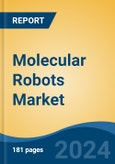Genetic Research is the fastest growing segment, North America is the largest market globally
Speak directly to the analyst to clarify any post sales queries you may have.
10% Free customizationThis report comes with 10% free customization, enabling you to add data that meets your specific business needs.
Key Market Drivers
The Global Molecular Robots Market is significantly propelled by two key factors: ongoing advancements in nanotechnology and materials science, and the expanding applications within precision medicine and targeted therapeutics. Progress in nanotechnology and materials science is foundational, enabling the precise fabrication and functionalization of molecular-scale devices. These advancements allow for the engineering of molecular robots with sophisticated capabilities, such as self-assembly, specific targeting, and controlled payload release, by providing novel materials with tunable properties and methods for their nanoscale manipulation.Key Market Challenges
The substantial initial capital investment required for the development and integration of complex molecular robotics platforms poses a significant impediment to the growth of the Global Molecular Robots Market. This high upfront cost creates a considerable barrier to entry for potential innovators and smaller enterprises, limiting competition and slowing the pace of technological advancement. The specialized nature of molecular robotics research and development demands expensive infrastructure, advanced instrumentation, and a highly skilled workforce, contributing to these elevated costs.Key Market Trends
The integration of Artificial Intelligence in molecular robotics represents a significant technological advancement. This trend focuses on equipping molecular systems with cognitive capabilities, enabling them to execute complex tasks with enhanced autonomy and precision at the nanoscale. Artificial intelligence facilitates intelligent decision-making, adaptive responses, and pattern recognition, moving molecular robots beyond pre-programmed actions. According to the International Federation of Robotics, in its February 2024 report on automation trends, the global operational stock of robots reached a record 3.9 million units, underscoring the expanding infrastructure for advanced robotic systems that increasingly incorporate AI.Key Market Players Profiled:
- Thermo Fisher Scientific Inc.
- Danaher Corporation
- PerkinElmer, Inc.
- Abbott Laboratories Inc.
- Bruker Corporation
- Qiagen N.V.
- F. Hoffmann-La Roche Ltd
- Siemens Healthineers AG
- Agilent Technologies, Inc.
- Hitachi High-Tech Corporation.
Report Scope:
In this report, the Global Molecular Robots Market has been segmented into the following categories:By Product Type:
- Software and Consumables
- Devices
By Application:
- Drug Discovery
- Genetic Research
- Others
By End User:
- Research Laboratories
- Pharma & Biotech Companies
By Region:
- North America
- Europe
- Asia Pacific
- South America
- Middle East & Africa
Competitive Landscape
Company Profiles: Detailed analysis of the major companies present in the Global Molecular Robots Market.Available Customizations:
With the given market data, the publisher offers customizations according to a company's specific needs. The following customization options are available for the report:- Detailed analysis and profiling of additional market players (up to five).
This product will be delivered within 1-3 business days.
Table of Contents
Companies Mentioned
- Thermo Fisher Scientific Inc.
- Danaher Corporation
- PerkinElmer, Inc.
- Abbott Laboratories Inc.
- Bruker Corporation
- Qiagen N.V.
- F. Hoffmann-La Roche Ltd
- Siemens Healthineers AG
- Agilent Technologies, Inc.
- Hitachi High-Tech Corporation.
Table Information
| Report Attribute | Details |
|---|---|
| No. of Pages | 181 |
| Published | November 2025 |
| Forecast Period | 2024 - 2030 |
| Estimated Market Value ( USD | $ 780 Million |
| Forecasted Market Value ( USD | $ 2400 Million |
| Compound Annual Growth Rate | 20.6% |
| Regions Covered | Global |
| No. of Companies Mentioned | 10 |









